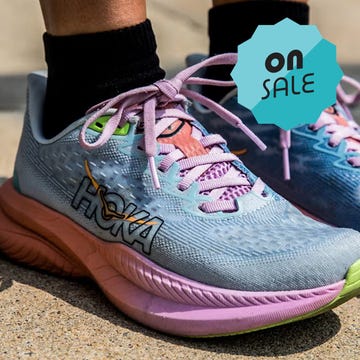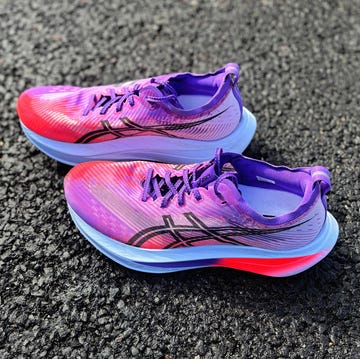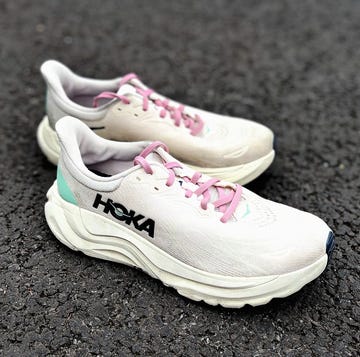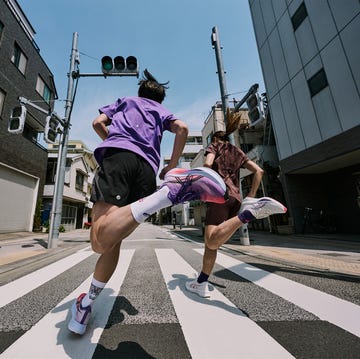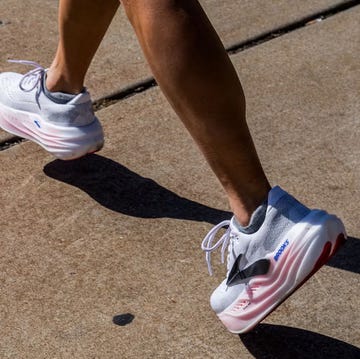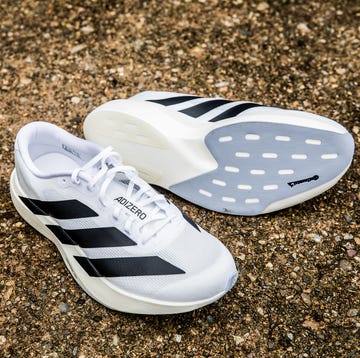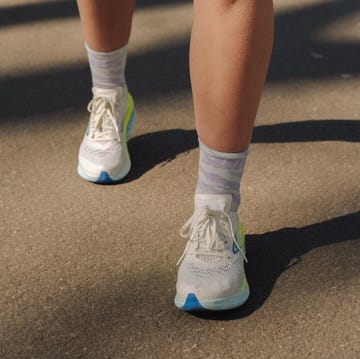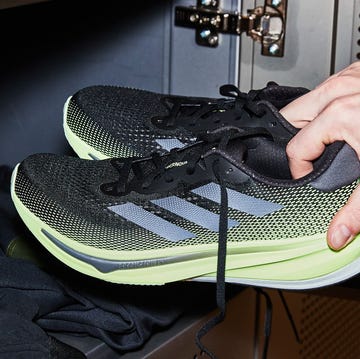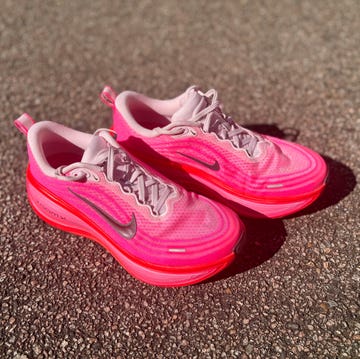Lightweight running shoes have come a long way as both racing flats and daily trainers. Once upon a time, to shave grams on a shoe and get it down to a competitive weight, brands had to make considerable compromises in comfort and stability — but that’s no longer the case. Thanks to lighter midsole foams and meshy upper materials, some of our favourite supportive and maximally cushioned shoes now sit well below 225g on the scale.
The appeal of lightweight shoes is simple: better running performance that takes less effort. Carrying less weight on your feet can result in less energy expenditure and improved form and biomechanics, which similarly boost stride economy and efficiency.
Brands have further refined their newest lightweight running shoes by analysing stride and gait patterns and using impact-measuring devices, which helps them create proprietary foams that return more energy with each footstrike. In short, the latest developments in design, chemistry, and biomechanics have led to shoes that can help you run faster and farther —or, at the very least, feel more nimble on your feet.
What everyone's reading
Of the hundreds of pairs of shoes we test each year at Runner’s World, the options below are the razor-thin racers, plush endurance trainers, and airy trail shoes that most impressed us with their phenomenal featherweight performance.
What to consider when buying lightweight shoes
Intended Use
When shoes get as light as the ones on this list are, the engineers in charge of designing them generally have a more specific purpose in mind for each model. It’s a natural consequence of eliminating redundancies in a shoe’s structure — they can’t always be all-rounders with loads of features and supports. Almost all of our picks are optimised for a specific task, such as high speeds on the road or achieving better ground feel on the trail. And they likely won’t feel as much like a good fit in a different setting.
Stability and Comfort
Don’t get us wrong: lightweight shoes with ample cushioning and effective stability measures do exist. However, they do take some searching to find, and they probably won’t be the cheapest. None of our picks here skimp on support enough to make every run miserable, but they’re certainly on the more responsive side. If you’re more concerned about the impact of landing than the lag from pulling your feet back off the ground, you’re a bit more limited unless you’re willing to look at heavier options, such as the kicks on our round-up of the best stability shoes.
How we test
The shoes below floated to the top of our charts as the lightest shoes in the bunch, and every pair offers some protective cushioning underfoot. Members of our test team, who evaluate hundreds of shoes a year, vetted these picks; they’ve run in at least one version of all the shoes on this list. And for the newest models they haven’t tested directly, we evaluated every feature that was updated carefully to ensure these are still top performers.
The best lightweight running shoes
The Rincon line has been a runner favourite since the original model’s release in 2019. It exhibits everything we love about Hoka, but it also has its own sense of identity that’s somewhat removed from the traditional Hoka image. It’s bountiful with cushioning, yet it has a more streamlined profile — instead of the quintessential hulky Hoka exterior — that’s built for everyday runs, speed work, and even some racing. One tester in particular was shocked by the amount of cushion built into this unassuming frame.
‘When I think of cushiony shoes nowadays, I think of tall stack height and visibly soft and cushiony elements,’ our tester noted. ‘By looking at this shoe, you would have no idea that it has one of the softest underfoot feelings on the market. I think that because there isn’t a whole lot of extra material, the shoe feels relatively responsive even with the soft underfoot feeling.’
This versatile trainer weighs less than previous iterations thanks to a redesigned (thinner) mesh upper, and it feels much more breathable. The cherry on top? This shoe is somehow more than an ounce lighter than the Clifton 9, which we’ve consistently lauded as one of our favourite daily trainers because of its lightness.
Not only are this shoe and Nike’s Alphafly two of the most iconic carbon-plated racing shoes on the market, this one is also among the lightest. Now in its third iteration, the Vaporfly hasn’t seen much transformation beyond a few light tweaks to its fit and materials, but that’s only because it worked so freakin’ well the first time around.
This time, however, the focus of this model’s update was optimising the shoe’s stability, and we believe Nike took this speedster in the right direction. The shoe now feels more planted in corners, which has always been a rough spot for shoes with as much foam as this one. And the tread under the forefoot is much more economically spread apart (no more massive slab of rubber), improving energy return without sacrificing too much grip.
Editor's note: The Vaporfly 4 is launching this March, which means the Vaporfly 3 is currently on discount.
Read our full New Balance FuelCell Rebel v4 review
The Rebel is all about energy return, and that makes it a great pick for uptempo training. The original performed way above average for energy return in our lab tests, and New Balance claims the v4 is the most responsive model yet. After our testing, we agree, and we also think it’s more comfortable, albeit only slightly. Expect an exceptionally firm and lively shoe once you lace this up — it isn’t quite a pillow for your feet, but boy, does it zip.
Using a similar silhouette to the race-ready FuelCell Supercomp Elite v4, this shoe is actually one of New Balance’s lightest thanks to its incredibly thin upper. Better yet, it’s also one of the brand’s most affordable, meaning you can give it a proper thrashing without feeling like you’re burning money.
You could say stability shoes have been a dying breed, but they’re not dead yet. And they’re not just for plodding along, either: just look at the Hyperion GTS 2, a lightweight, stable speedster that’s well-suited for track sessions, tempo runs, and even racing. The upper and midsole might not have the most robust support structure on the market, but this shoe finds a respectable balance between guiding your stride in the right direction and letting you flick your feet untethered by any stiff, clunky heel blocks.
The GTS 2 wowed several of our testers with its deceptively plush cushioning. One runner remarked that it may be too much squish if you prefer to ‘feel the road’ but that cushioning might also keep you from getting crabby at the end of a long run.
Read our full Hoka Mach 6 review
Another entry from Hoka, the Mach line is built for speed work sessions and, for those who don't want to entail the cost of a carbon plate, race day. Our testers raved about the previous versions, and while Hoka made some big changes between the Mach 5 and Mach 6, it’s still a fast, lightweight and responsive ride with an updated fit.
The Mach 6 uses a fully supercritical foam midsole for even more energy return, along with a narrower, more streamlined shape – which, in itself, makes it feel like a ‘fast’ shoe – as well as a slightly thinner toe box. The shoe particularly comes into its own for mixed pace sessions as it can perform well, over long periods, at a range of speeds.
And while the shoe is still designed to be firmer than the brand’s ultra-plush models, a moulded EVA sockliner adds extra step-in comfort and the internal gusset hugs your foot for a custom feel.
Read our full Inov8 Trailfly Speed review
As its name suggests, the Trailfly Speed is built for quicker running, but more specifically, it's designed with dryer trails in mind. Despite being a more stripped-down shoe with a lower profile, it still offers an impressively comfortable ride. ‘Straight out the box, the shoe is a joy to run in,’ said one tester. There’s ample room in the forefoot, too, while the lacing system and tongue feel comfortable and secure. Like the best trail shoes, it essentially disappears on your foot, offering a low-key, drama-free running experience.
The stack height is relatively low – 22mm in the heel and 18mm in the forefoot – which gives you a better feel of the ground. However, there's no denying that the Trailfly Speed is going to be a bit too minimal for those who are accustomed to a plusher running shoe. If that’s you, it’s likely that you’d be better suited to the Trailfly, which has a higher stack height and more cushioning, though this obviously makes it a slightly heavier shoe.
The Trailfly Speed's 4mm lugs held up surprisingly well in moderate mud, wet grass, sand and harder trails. As such, you could probably look at them as a three-season trail shoe that will hold up to everything other than the worst wintry conditions.








